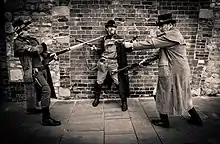Mexican standoff
A Mexican standoff is a confrontation where no strategy exists that allows any party to achieve victory.[1][2] Any party initiating aggression might trigger their own demise. At the same time, the parties are unable to extract themselves from the situation without suffering a loss. As a result, all participants need to maintain the strategic tension, which remains unresolved until some outside event or interparty dialogue makes it possible to resolve it.

The term Mexican standoff was originally used in the context of using firearms and it still commonly implies a situation in which the parties face some form of threat from the other parties. The Mexican standoff is a recurring cinematic trope, in which armed characters hold each other at gunpoint.
Etymology
Sources claim the reference is to the Mexican–American War or post-war Mexican bandits in the 19th century.[3]
The earliest known use of the phrase in print was on 19 March 1876, in a short story about Mexico, featuring the line:[4]
"Go-!" said he sternly then. "We will call it a stand-off, a Mexican stand-off, you lose your money, but you save your life!"
— F. Harvey Smith, Sunday Mercury, New York, 1876[5]
Popular culture
In popular culture, the term Mexican standoff references confrontations in which neither opponent appears to have a measurable advantage. Historically, commentators have used the term to reference the Soviet Union – United States nuclear confrontation during the Cold War, specifically the Cuban Missile Crisis of 1962. The key element that makes such situations Mexican standoffs is the equality of power exercised amongst the involved parties.[3] The inability of any particular party to advance its position safely is a condition common amongst all standoffs; in a "Mexican standoff", however, there is an additional disadvantage: no party has a safe way to withdraw from its position, thus making the standoff effectively permanent.
A Mexican standoff where each party is threatening another with a gun is now considered a movie cliché, stemming from its frequent use as a plot device in cinema. The classic exemplar of the trope is in Sergio Leone's 1966 Western The Good, the Bad and the Ugly, where the eponymous characters, played by Clint Eastwood, Lee Van Cleef and Eli Wallach, face each other in a showdown.[6][7]
Director John Woo, considered a major influence on the action film genre, is known for his highly chaotic action sequences, Mexican standoffs, and frequent use of slow motion.[8] Director Quentin Tarantino (who has cited Woo as an influence) has featured Mexican standoff scenes in films including Inglourious Basterds (the tavern scene features multiple Mexican standoffs including meta-discussion) and Reservoir Dogs, which depicts a standoff among four characters in the climactic scene.[9]
See also
References
- Buytendijk, Frank (2010). Dealing with Dilemmas: Where Business Analytics Fall Short. Wiley. p. 20. ISBN 978-0-470-76848-8.
- V&S Editorial Board (2015). Concise Dictionary of English Combined (idioms, Phrases, Proverbs, Similes). V&S Publishers. p. 94. ISBN 9789352150502.
- "Mexican standoff", The Word Detective, retrieved 2013-03-21
- "Mexican, n. and adj.". OED Online. March 2018. Oxford University Press.
- Helgesen, Stephan (January 16, 2019). "Our nation is stuck in a standoff". Albuquerque Journal. p. A15.
- Jew, Anson (2013). Professional Storyboarding: Rules of Thumb. Taylor & Francis. p. 83. ISBN 978-1-136-12677-2.
- Buckmaster, Luke. "The lasting legacy of The Good, the Bad and the Ugly", BBC.com, Wednesday 10 February 2016. Retrieved October 26,2018
- Pierce, Nev (24 September 2014). "Calling The Shots: John Woo". BBC.
- Bailey, Jason (2013). Pulp Fiction: The Complete Story of Quentin Tarantino's Masterpiece. Voyageur Press. p. 45. ISBN 978-0-7603-4479-8.
External links
 The dictionary definition of Mexican standoff at Wiktionary
The dictionary definition of Mexican standoff at Wiktionary